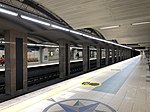Hospital Real de Todos-os-Santos
1504 establishments in Portugal1755 disestablishments in PortugalBuildings and structures demolished in 1775Buildings and structures in LisbonDefunct hospitals in Portugal ... and 7 more
Demolished buildings and structures in PortugalGothic architecture in PortugalHistory of LisbonHospitals disestablished in 1755Hospitals established in the 16th centuryInfrastructure completed in 1504Manueline architecture

The Hospital Real de Todos-os-Santos (All Saints Royal Hospital) was a major hospital in Lisbon, Portugal. The hospital was built between 1492 and 1504 and was destroyed in the 1755 Lisbon earthquake, along with most of the city. It was never fully rebuilt and was finally demolished in 1775.
Excerpt from the Wikipedia article Hospital Real de Todos-os-Santos (License: CC BY-SA 3.0, Authors, Images).Hospital Real de Todos-os-Santos
Praça da Figueira, Lisbon Santa Maria Maior (Santa Maria Maior)
Geographical coordinates (GPS) Address Nearby Places Show on map
Geographical coordinates (GPS)
| Latitude | Longitude |
|---|---|
| N 38.7136 ° | E -9.13839 ° |
Address
Praça da Figueira
1100-090 Lisbon, Santa Maria Maior (Santa Maria Maior)
Portugal
Open on Google Maps









